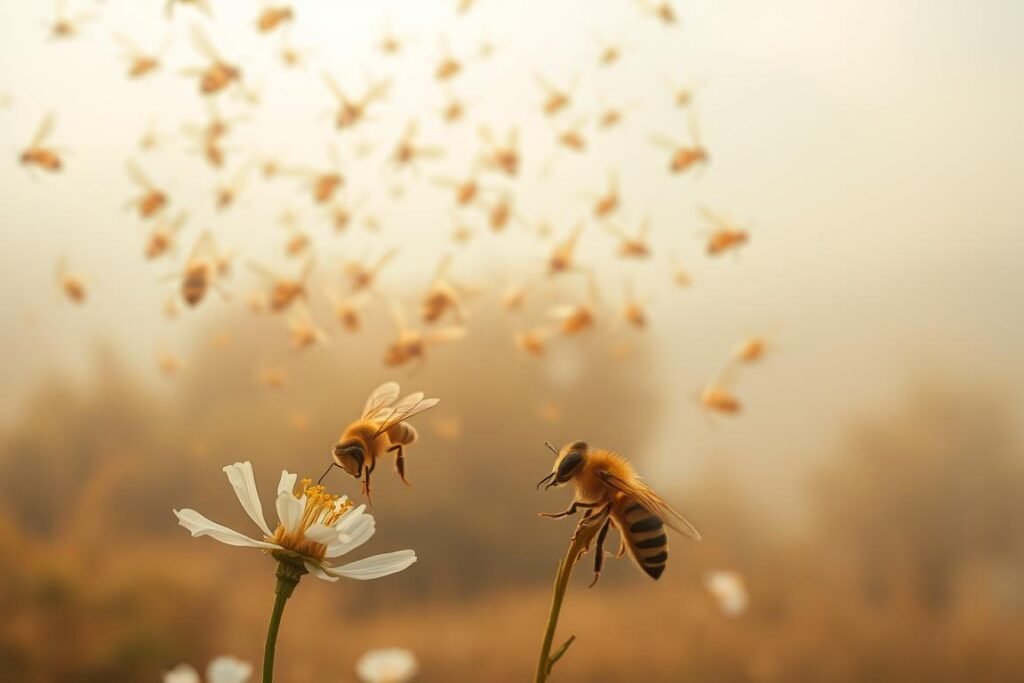Seeing tiny creatures in your sleep can spark curiosity. Many people experience this, and interpretations vary widely. Some cultures view these visions as signs of change, while others link them to hidden fears.
Science suggests these nighttime images may relate to memory or emotions. Studies show that REM sleep helps the mind process daily experiences. The type of creature and your feelings in the moment shape the meaning.
Symbolism often connects to transformation or resilience. A butterfly might represent growth, while ants could signal hard work. Context matters—what emotions arise when you recall the vision?
This article explores common interpretations, psychological insights, and ways to analyze your own experiences. Understanding these symbols can offer clarity in waking life.
Introduction to Dreaming About Insects
The presence of small beings in sleep has puzzled humans for centuries. Studies show that 60-80% of people experience these visions, often tied to emotions or memories. These nighttime images can carry deep meanings, shaped by cultural and psychological factors.
Why Do Insects Appear in Our Dreams?
From an evolutionary perspective, these visions may serve as a form of threat simulation. The brain processes potential dangers, even in sleep. This theory, proposed by Revonsuo, suggests that these images help prepare us for real-life challenges.
Psychologically, Freud’s concept of “displacement” explains how these beings act as censors for deeper fears. Jung, on the other hand, linked them to the collective unconscious, representing shared human experiences.
The Historical and Cultural Significance of Insect Dreams
Different cultures attach unique meanings to these visions. In ancient Egypt, the scarab beetle symbolized resurrection and renewal. In contrast, Biblical references to locusts often signify destruction and chaos.
James Hillman’s psychoanalytic view adds another layer, suggesting that these beings represent inhuman monstrosities. This perspective highlights the complexity of interpreting such visions.
| Perspective | Interpretation |
|---|---|
| Evolutionary | Threat simulation theory (Revonsuo) |
| Freudian | Displacement of deeper fears |
| Jungian | Connection to the collective unconscious |
| Cultural | Scarab beetle (resurrection) vs. locusts (destruction) |
| Psychoanalytic | Representation of inhuman monstrosities (Hillman) |
Understanding these interpretations can help you decode the messages your subconscious is trying to convey. Whether tied to fear, transformation, or cultural symbolism, these visions offer a window into your waking thoughts and emotions.
Understanding the Symbolism of Insects in Dreams
The appearance of tiny beings in sleep often carries deeper meanings. These visions can reflect inner thoughts and emotions, offering insights into the mind. Whether they symbolize transformation or evoke fear, their significance varies widely.
Insects as Symbols of Transformation and Change
Butterflies are often linked to spiritual growth and renewal. Their metamorphosis from caterpillar to butterfly mirrors personal transformation. On the other hand, moths may represent hidden flaws or unresolved issues.
Scarab beetles, revered in ancient Egypt, symbolize rebirth and transformation. This contrasts with spiders, which can signify feminine creativity or feelings of entrapment. Understanding these symbols helps decode the messages in your visions.
Negative Connotations: Fear and Anxiety in Insect Dreams
For some, these visions evoke fear and anxiety. Cockroaches, for instance, may symbolize repressed guilt or shame. A case study involving Martha revealed that her cockroach visions reflected unresolved sexual guilt.
Children’s visions of these beings often reflect feelings of powerlessness. Infestations, such as swarms of ants or mosquitoes, may indicate subconscious self-judgment or disgust. These negative connotations highlight the complexity of interpreting such visions.
| Symbol | Positive Meaning | Negative Meaning |
|---|---|---|
| Butterfly | Spiritual growth, transformation | N/A |
| Moth | N/A | Hidden flaws, unresolved issues |
| Scarab Beetle | Rebirth, renewal | N/A |
| Spider | Feminine creativity | Entrapment, fear |
| Cockroach | N/A | Repressed guilt, shame |
These interpretations provide a way to explore your feelings and thoughts. By analyzing the symbolism, you can gain clarity on the messages your subconscious is conveying.
Common Insects in Dreams and Their Meanings
Many cultures and traditions have long interpreted the presence of small creatures in sleep as meaningful symbols. These visions often reflect personal emotions, cultural beliefs, or subconscious thoughts. Below, we explore the significance of three common beings: ants, bees, and butterflies.
Ants: Hard Work and Teamwork
Ants are often associated with diligence and collective effort. In Proverbs 30:25, they are praised for their strength in unity. However, seeing them may also signal feelings of insignificance or restlessness. Their presence can remind us of the value of hard work and collaboration in our waking life.
Bees: Harmony and Hard Work Paying Off
Bees symbolize prosperity and harmony. Druid traditions link them to the sun, representing energy and growth. Freud’s interpretation connects them to phallic symbolism, hinting at deeper desires. A bee sting in these visions may warn of envy, while their presence often signifies that hard work is paying off.
Butterflies: Transformation and Spiritual Growth
Butterflies are universal symbols of change and renewal. In Christianity, they represent resurrection, while in Chinese culture, they signify joy and good luck. The color of the butterfly matters—monarchs symbolize rebirth, while black ones may indicate mourning. Their appearance often marks a period of personal or spiritual transformation.
- Ants: Represent teamwork but may also reflect restlessness.
- Bees: Symbolize prosperity and harmony, with stings warning of envy.
- Butterflies: Linked to transformation, joy, and spiritual growth.
Interpreting Specific Insect Dreams
Specific visions of certain creatures can reveal unique insights into your subconscious. Each being carries its own symbolism, often tied to emotions or experiences. Below, we explore the meanings behind spiders, cockroaches, and mosquitoes.
Dreaming About Spiders: Creativity and Feminine Energy
Spiders often symbolize creativity and feminine energy. In Greek mythology, the story of Arachne highlights their connection to artistry and transformation. However, they can also represent a “web of lies,” reflecting duality in their meaning.
For some, spiders evoke fear, while others see them as a sign of patience and resourcefulness. Their presence may encourage you to explore your creative side or address hidden issues in your life.
Cockroaches in Dreams: Resilience and Hidden Problems
Cockroaches are symbols of tenacity and survival. They thrive in challenging environments, representing resilience. However, they can also point to hidden shame or unresolved feelings.
In therapy, a case study involving Martha revealed that her cockroach visions reflected repressed guilt. This contrasts with ancient Egyptian beliefs, where they symbolized immortality. Their appearance may urge you to confront hidden challenges.
Mosquitoes: Minor Annoyances and Hidden Threats
Mosquitoes often symbolize minor irritations or hidden threats. In Gypsy interpretations, they represent persecution, while in Islamic traditions, they can signify blessings. Their presence may highlight small but persistent issues in your life.
Killing a mosquito in your vision can signal overcoming obstacles. Their buzzing may remind you to address lingering problems before they grow. Understanding their symbolism can help you tackle these challenges effectively.
- Spiders: Represent creativity and feminine energy, but may also evoke fear.
- Cockroaches: Symbolize resilience but can point to hidden shame.
- Mosquitoes: Highlight minor annoyances or hidden threats.
Psychological Perspectives on Insect Dreams
Exploring the psychological significance of these nighttime visions can offer profound insights. The mind often uses symbols to process emotions, fears, and desires. Two prominent theories—Freudian and Jungian—provide unique interpretations of these symbols.
Freudian Interpretation: Insects as Symbols of Hidden Desires
Sigmund Freud believed that these visions often mask deeper fears or repressed desires. For example, his analysis of a may-beetle vision linked it to repressed sexuality. Freud’s displacement theory suggests that these symbols can represent traumatic events, such as car accidents, in a less threatening way.
Jungian Analysis: Insects and the Collective Unconscious
Carl Jung viewed these symbols as part of the collective unconscious. He believed that beetles, for instance, are universal symbols rather than personal archetypes. Jung’s “phylogenetic” progression in a depressed patient highlights how these visions can reflect shared human experiences and emotions.
Medard Boss’s three-year study of insect-filled visions in therapy further supports these ideas. His work shows how these symbols can reveal unresolved feelings and provide a path to healing. Understanding these psychological perspectives can help you decode the messages your subconscious is conveying.
| Theory | Key Interpretation |
|---|---|
| Freudian | Insects as symbols of hidden desires or trauma |
| Jungian | Insects as part of the collective unconscious |
| Boss’s Study | Insects revealing unresolved feelings in therapy |
By analyzing these visions through a psychological lens, you can gain a deeper understanding of your inner life. Whether they reflect hidden fears or universal symbols, these interpretations offer valuable insights into your subconscious.
How to Analyze Your Insect Dreams
Understanding the messages behind your nighttime visions can provide valuable insights into your daily life. By paying attention to recurring symbols and emotions, you can uncover hidden thoughts and feelings. This section offers practical steps to decode these visions and apply their meanings to your waking experiences.
Keeping a Dream Journal: Tracking Recurring Insect Symbols
Start by recording details of your visions in a journal. Note the colors, actions, and emotions associated with the creatures. For example, do you feel disgust or curiosity? This practice helps identify patterns and recurring themes.
Here are some tips for effective journaling:
- Write immediately after waking to capture fresh memories.
- Focus on the creature’s behavior and your emotional response.
- Look for connections between these visions and your daily life.
Connecting Dream Symbols to Your Waking Life
Once you’ve identified recurring symbols, explore their relevance to your waking experiences. For instance, visions of ants might reflect workplace stress or collaboration challenges. Similarly, the “kick the cockroach” metaphor can help address self-criticism and hidden shame.
Ask yourself these questions:
- What emotions do these visions evoke?
- Do they mirror any current challenges or situations?
- How can you apply these insights to improve your way of thinking?
By analyzing and connecting these symbols, you can gain clarity and take meaningful steps toward personal growth.
Cultural Interpretations of Insect Dreams
Across history, tiny beings in visions have held deep cultural weight. Different societies assign unique symbols to these creatures, shaping beliefs and rituals. From sacred scarabs to ominous locusts, their meaning reflects values and fears.
Insects in Ancient Egyptian Dream Interpretation
Scarabs were sacred symbols of rebirth, tied to Ra and solar cycles. Egyptians buried them with the dead to ensure safe passage. This contrasts with others, like flies, which symbolized decay.
Butterflies also signified good luck and transformation. Their metamorphosis mirrored the soul’s journey. These beliefs highlight how cultures linked small creatures to larger truths about life.
Biblical References to Insects in Dreams
Exodus 10:4-15 depicts locusts as divine punishment, devouring crops. Yet Proverbs 6:6 praises ants for diligence, shaping the way societies view hard work. Lice, another Biblical symbol, represented moral impurity.
- Islamic traditions: Fleas were called “Allah’s soldiers,” testing faith.
- Hindu symbolism: Wasps embodied focus, unlike chaotic Western views.
These contrasts reveal how the same creature can hold opposing meaning across cultures. Whether as omens or guides, their roles reflect shared human questions.
Insects in Popular Culture and Dreams
From literature to film, bugs have long been symbols of deeper human emotions and fears. Their presence in stories and art often reflects societal anxieties or personal struggles. Whether as metaphors for alienation or representations of danger, these creatures leave a lasting impact on our imagination.

Insects in Literature and Film: Symbolism and Interpretation
Franz Kafka’s “The Metamorphosis” uses a cockroach to symbolize alienation and existential dread. The protagonist’s transformation into a bug highlights feelings of isolation and societal rejection. Similarly, Salvador Dalí’s art often features ants and beetles, representing decay and the passage of time.
In modern media, spiders are frequently tied to themes of danger and femininity. Marvel’s Black Widow character draws parallels to the myth of Arachne, blending strength with vulnerability. The “Alien” franchise uses parasitic creatures to evoke primal fear, influencing how we perceive threats in our subconscious.
How Modern Media Influences Our Dream Imagery
Films and literature shape the way we interpret symbols in our sleep. The portrayal of bugs as menacing or transformative can influence our nighttime visions. For example, the recurring image of a spider in a movie might later appear in a dream, carrying similar connotations of danger or creativity.
Here’s a summary of how insects are depicted in popular culture:
| Insect | Symbolism | Example |
|---|---|---|
| Cockroach | Alienation, decay | Kafka’s “The Metamorphosis” |
| Spider | Danger, femininity | Marvel’s Black Widow |
| Beetle | Time, transformation | Dalí’s art |
| Others | Fear, parasitism | “Alien” franchise |
Understanding these portrayals can help decode the messages in your subconscious. Whether through literature or film, these creatures continue to shape our perceptions and dreams.
Overcoming Fear in Insect Dreams
Facing unsettling visions during the night can feel overwhelming. These experiences often trigger deep emotional responses, leaving a lasting impact on your mind. Understanding and addressing these fears can help restore peace and clarity.
Techniques for Confronting Nightmares About Insects
One effective method is exposure therapy. Gradually visualize confronting infestations step-by-step. This approach helps desensitize your feelings of fear and builds resilience.
Mindfulness is another powerful tool. Reframe disgust as curiosity by asking, “Why is this bug here?” This shift in attention can transform a negative situation into an opportunity for self-discovery.
- Visualize the creature in a controlled setting.
- Focus on your breathing to stay calm.
- Identify the emotions tied to the vision.
Using Meditation to Understand and Resolve Insect Dreams
Guided meditation can help uncover the root of your fears. For example, Martha’s case study showed that eradicating cockroach visions reduced her anxiety. Meditation allows you to explore these symbols in a safe, controlled environment.
Try this simple meditation practice:
- Find a quiet space and close your eyes.
- Visualize the creature and observe your reaction.
- Release any negative emotions with each exhale.
By addressing these visions, you can turn a troubling night into a path toward healing and growth.
The Role of Insects in Lucid Dreaming
Lucid dreaming offers a unique way to interact with the symbols your mind creates during sleep. This state of awareness allows you to explore and even control your nighttime visions, providing deeper insights into their meanings. Insects, in particular, can play a significant role in these experiences, often serving as powerful metaphors or messages.
How to Recognize Insects in Lucid Dreams
In lucid dreams, insects may appear more vivid or behave unusually. For example, a mosquito might speak, or a spider could move in ways that defy logic. These inconsistencies can serve as reality checks, helping you realize you’re in a dream. Studies on REM sleep behavior disorder have shown that vivid insect chases are common in certain sleep conditions, further highlighting their significance.
Here are some tips to identify these creatures in your lucid dreams:
- Look for unusual behavior, such as talking or oversized insects.
- Pay attention to your emotional response—do you feel curiosity or fear?
- Use these moments to confirm you’re in a dream and take control.
Using Lucid Dreaming to Explore Insect Symbolism
Once you recognize these creatures, you can engage with them to uncover their meanings. For instance, asking a spider its purpose might reveal insights about creativity or hidden fears. Research on narcolepsy hallucinations involving insects suggests that these visions often reflect deeper emotional or psychological themes.
Here’s how to explore their symbolism:
- Interact with the insect—ask questions or observe its behavior.
- Reflect on the emotions and thoughts it evokes in your waking situation.
- Use these insights to address challenges or gain clarity in your daily life.
By leveraging lucid dreaming, you can transform unsettling visions into opportunities for self-discovery and growth.
Insects as Messengers in Dreams
Insects in your nighttime visions often carry hidden messages. These creatures can act as symbols from your subconscious, reflecting deeper thoughts or emotions. By paying attention to their presence, you can uncover valuable insights into your inner world.
What Your Subconscious is Trying to Tell You
Your mind uses these creatures to communicate. For example, ladybugs might signal good fortune or a need for self-love. Grasshoppers can represent forward momentum, while locusts may symbolize the destruction of goals. Each creature carries a unique message tied to your current issues or emotions.
Decoding the Messages Behind Insect Visions
James Hillman’s “Going Bugs” essay suggests that these beings act as forgotten gods, offering guidance. Decoding their meanings requires reflection. For instance, lice might represent energy vampires or unresolved guilt. Here’s a quick guide to interpreting these symbols:
- Ladybugs: A sign of good luck or a reminder to practice self-love.
- Grasshoppers: Symbolize progress but can also warn of setbacks.
- Lice: Often tied to feelings of guilt or draining relationships.
By understanding these symbols, you can address the challenges or emotions they represent. Whether they bring warnings or encouragement, these visions offer a window into your subconscious mind.
How to Use Insect Dreams for Personal Growth
Your nighttime visions can be more than just random images—they can serve as tools for personal development. By analyzing these symbols, you can uncover hidden emotions and apply their meanings to your waking life. This section explores practical ways to turn these visions into opportunities for growth.

Applying Dream Interpretations to Improve Your Life
Insect symbolism can offer valuable insights into your daily challenges. For example, seeing ants might remind you to embrace teamwork in your work environment. Butterflies, on the other hand, could signal a time for transformation or career changes.
Here’s how to apply these interpretations:
- Reflect on the emotions tied to the vision—do they align with current issues?
- Use the creature’s symbolism as a guide for making decisions.
- Transform negative symbols, like cockroaches, into resilience in your way of thinking.
Turning Nightmares into Opportunities for Self-Discovery
Unsettling visions can be powerful tools for confronting fears. For instance, a case study involving an engineer showed how insect-filled visions helped him recover from burnout. By addressing these symbols, he found clarity and regained a sense of order in his life.
Here are steps to turn nightmares into growth opportunities:
- Identify the underlying feelings tied to the vision.
- Use meditation or journaling to explore its meaning.
- Apply the insights to address real-life challenges.
| Insect | Symbolism | Application to Life |
|---|---|---|
| Ants | Teamwork, diligence | Improve collaboration at work |
| Butterflies | Transformation, growth | Navigate career or personal changes |
| Cockroaches | Resilience, hidden shame | Confront and overcome fears |
By understanding and applying these symbols, you can transform your nighttime visions into tools for personal growth. Whether they bring warnings or encouragement, these messages offer a unique way to improve your life.
Scientific Studies on Insects in Dreams
Scientific research delves into the intriguing connection between nighttime visions and psychological well-being. These studies explore how such experiences influence the mind and emotions, offering insights into their deeper meanings.
Research on the Psychological Impact of Insect Dreams
Studies reveal that visions involving small creatures can evoke strong emotional responses. For example, a 78-child study linked these experiences to feelings of powerlessness. This highlights how such symbols reflect inner struggles or unresolved fears.
Research also examines the prevalence of these visions in REM versus non-REM sleep. Findings suggest that vivid insect-related imagery is more common during REM sleep, a phase associated with emotional processing.
Case Studies: How Insect Dreams Affect Mental Health
Case studies provide deeper insights into the mental health implications of these visions. One notable example involved a sleepwalking patient who hallucinated cockroaches, revealing underlying anxiety and trauma.
Another study explored PTSD correlations, finding that recurrent spider-related nightmares often signify unresolved fears. These findings emphasize the importance of addressing such symbols in therapy.
- Childhood visions: Linked to feelings of powerlessness.
- REM sleep: More likely to feature vivid insect imagery.
- PTSD correlations: Recurrent spider nightmares reflect unresolved trauma.
By understanding these scientific perspectives, we can better address the emotional and psychological impact of these nighttime experiences.
Final Thoughts on Dreaming About Insects
Nighttime visions of small creatures can reveal profound insights into your inner world. These experiences often symbolize transformation, fear, and cultural diversity, reflecting the complexity of the human mind.
To better understand these symbols, consider keeping a journal. Tracking recurring patterns can help uncover hidden emotions and provide clarity in your waking life. This practice empowers you to decode the meaning behind these visions.
Even unsettling nightmares offer growth opportunities. By confronting these fears, you can turn challenges into a way to build resilience and self-awareness. Explore more about the psychological impact of these visions in this scientific study.
Embrace these nighttime messages as tools for personal development. Whether they inspire change or highlight fears, they provide a unique path to understanding yourself.







